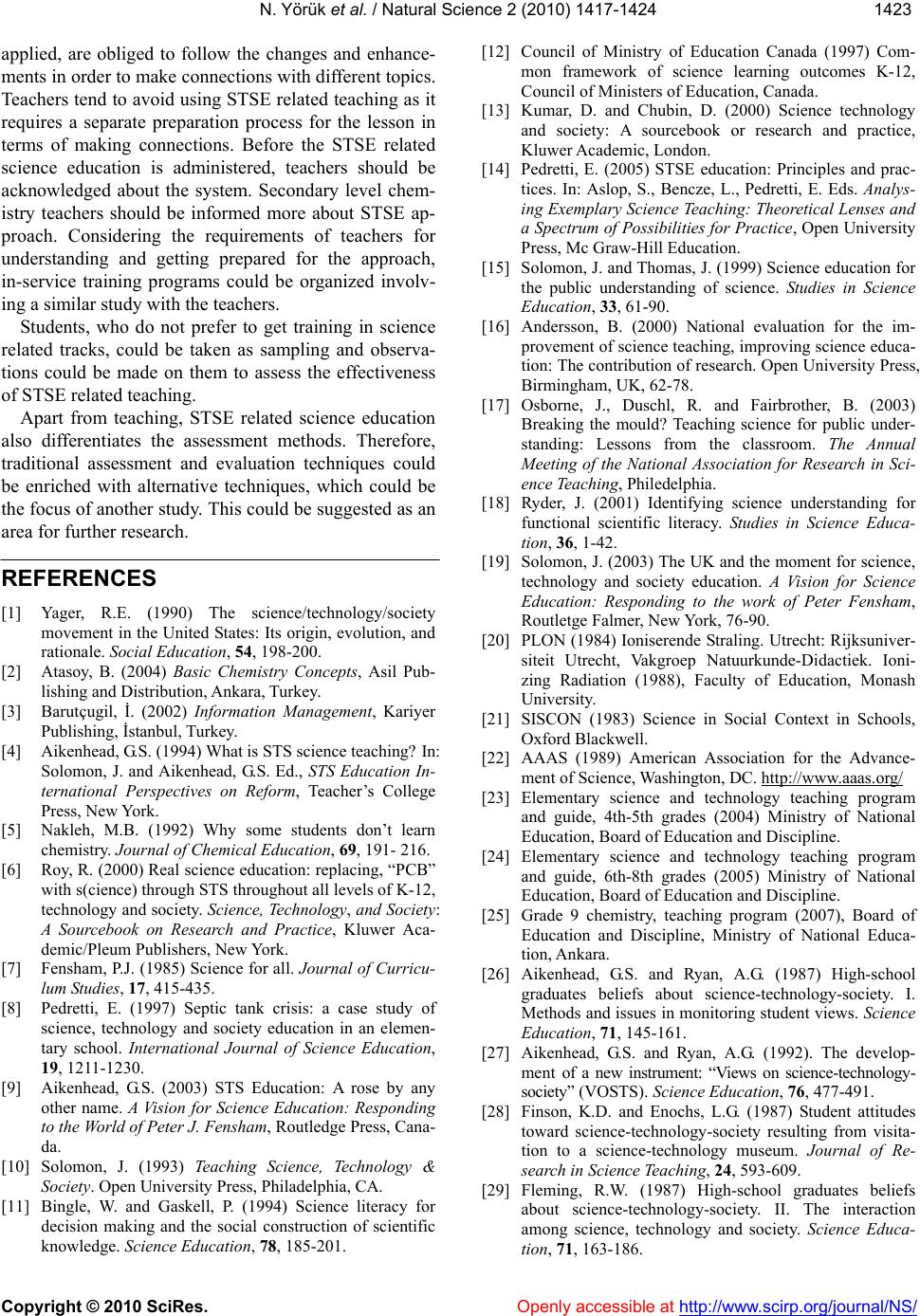
N. Yörük et al. / Natural Scien c e 2 (2010) 1417-1424
Copyright © 2010 SciRes. Openly accessible at http://www.scirp.org/journal/NS/
142
1423
applied, are obliged to follow the changes and enhance-
ments in order to make connections with different topics.
Teachers tend to avoid using STSE related teaching as it
requires a separate preparation process for the lesson in
terms of making connections. Before the STSE related
science education is administered, teachers should be
acknowledged about the system. Secondary level chem-
istry teachers should be informed more about STSE ap-
proach. Considering the requirements of teachers for
understanding and getting prepared for the approach,
in-service training programs could be organized involv-
ing a similar study with the teachers.
Students, who do not prefer to get training in science
related tracks, could be taken as sampling and observa-
tions could be made on them to assess the effectiveness
of STSE related teaching.
Apart from teaching, STSE related science education
also differentiates the assessment methods. Therefore,
traditional assessment and evaluation techniques could
be enriched with alternative techniques, which could be
the focus of another study. This could be suggested as an
area for further research.
REFERENCES
[1] Yager, R.E. (1990) The science/technology/society
movement in the United States: Its origin, evolution, and
rationale. Social Education, 54, 198-200.
[2] Atasoy, B. (2004) Basic Chemistry Concepts, Asil Pub-
lishing and Distribution, Ankara, Turkey.
[3] Barutçugil, İ. (2002) Information Management, Kariyer
Publishing, İstanbul, Turkey.
[4] Aikenhead, G.S. (1994) What is STS science teaching? In:
Solomon, J. and Aikenhead, G.S. Ed., STS Education In-
ternational Perspectives on Reform, Teacher’s College
Press, New York.
[5] Nakleh, M.B. (1992) Why some students don’t learn
chemistry. Journal of Chemical Education, 69, 191- 216.
[6] Roy, R. (2000) Real science education: replacing, “PCB”
with s(cience) through STS throughout all levels of K-12,
technology and society. Science, Technology, and Society:
A Sourcebook on Research and Practice, Kluwer Aca-
demic/Pleum Publishers, New York.
[7] Fensham, P.J. (1985) Science for all. Journal of Curricu-
lum Studies, 17, 415-435.
[8] Pedretti, E. (1997) Septic tank crisis: a case study of
science, technology and society education in an elemen-
tary school. International Journal of Science Education,
19, 1211-1230.
[9] Aikenhead, G.S. (2003) STS Education: A rose by any
other name. A Vision for Science Education: Responding
to the World of Peter J. Fensham, Routledge Press, Cana-
da.
[10] Solomon, J. (1993) Teaching Science, Technology &
Society. Open University Press, Philadelphia, CA.
[11] Bingle, W. and Gaskell, P. (1994) Science literacy for
decision making and the social construction of scientific
knowledge. Science Education, 78, 185-201.
[12] Council of Ministry of Education Canada (1997) Com-
mon framework of science learning outcomes K-12,
Council of Ministers of Education, Canada.
[13] Kumar, D. and Chubin, D. (2000) Science technology
and society: A sourcebook or research and practice,
Kluwer Academic, London.
[14] Pedretti, E. (2005) STSE education: Principles and prac-
tices. In: Aslop, S., Bencze, L., Pedretti, E. Eds. Analys-
ing Exemplary Science Teaching: Theoretical Lenses and
a Spectrum of Possibilities for Practice, Open University
Press, Mc Graw-Hill Education.
[15] Solomon, J. and Thomas, J. (1999) Science education for
the public understanding of science. Studies in Science
Education, 33, 61-90.
[16] Andersson, B. (2000) National evaluation for the im-
provement of science teaching, improving science educa-
tion: The contribution of research. Open University Press,
Birmingham, UK, 62-78.
[17] Osborne, J., Duschl, R. and Fairbrother, B. (2003)
Breaking the mould? Teaching science for public under-
standing: Lessons from the classroom. The Annual
Meeting of the National Association for Research in Sci-
ence Te achin g, Philedelphia.
[18] Ryder, J. (2001) Identifying science understanding for
functional scientific literacy. Studies in Science Educa-
tion, 36, 1-42.
[19] Solomon, J. (2003) The UK and the moment for science,
technology and society education. A Vision for Science
Education: Responding to the work of Peter Fensham,
Routletge Falmer, New York, 76-90.
[20] PLON (1984) Ioniserende Straling. Utrecht: Rijksuniver-
siteit Utrecht, Vakgroep Natuurkunde-Didactiek. Ioni-
zing Radiation (1988), Faculty of Education, Monash
University.
[21] SISCON (1983) Science in Social Context in Schools,
Oxford Blackwell.
[22] AAAS (1989) American Association for the Advance-
ment of Science, Washington, DC. http://www.aaas.org/
[23] Elementary science and technology teaching program
and guide, 4th-5th grades (2004) Ministry of National
Education, Board of Education and Discipline.
[24] Elementary science and technology teaching program
and guide, 6th-8th grades (2005) Ministry of National
Education, Board of Education and Discipline.
[25] Grade 9 chemistry, teaching program (2007), Board of
Education and Discipline, Ministry of National Educa-
tion, Ankara.
[26] Aikenhead, G.S. and Ryan, A.G. (1987) High-school
graduates beliefs about science-technology-society. I.
Methods and issues in monitoring student views. Science
Education, 71, 145-161.
[27] Aikenhead, G.S. and Ryan, A.G. (1992). The develop-
ment of a new instrument: “Views on science-technology-
society” (VOSTS). Science Education, 76, 477-491.
[28] Finson, K.D. and Enochs, L.G. (1987) Student attitudes
toward science-technology-society resulting from visita-
tion to a science-technology museum. Journal of Re-
search in Science Teaching, 24, 593-609.
[29] Fleming, R.W. (1987) High-school graduates beliefs
about science-technology-society. II. The interaction
among science, technology and society. Science Educa-
tion, 71, 163-186.